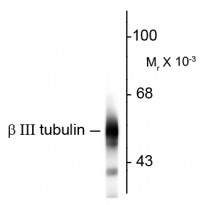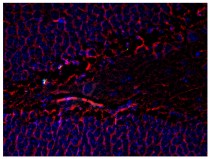ARG52460
anti-beta III Tubulin antibody [AA10]
anti-beta III Tubulin antibody [AA10] for IHC-Formalin-fixed paraffin-embedded sections,Western blot and Mouse,Rat
Controls and Markers antibody; Neuroscience antibody; Signaling Transduction antibody; Neuron Development Study antibody; Neuronal Cytoskeletal antibody; Neurite Marker antibody

1
Overview
| Product Description | Mouse Monoclonal antibody [AA10] recognizes Tubulin, beta III |
|---|---|
| Tested Reactivity | Ms, Rat |
| Tested Application | IHC-P, WB |
| Host | Mouse |
| Clonality | Monoclonal |
| Clone | AA10 |
| Isotype | IgG |
| Target Name | beta III Tubulin |
| Antigen Species | Rat |
| Immunogen | Synthetic peptide corresponding to amino acid residues specific to beta III Tubulin conjugated to KLH |
| Conjugation | Un-conjugated |
| Alternate Names | CDCBM1; Tubulin beta-4 chain; Tubulin beta-3 chain; CFEOM3A; Tubulin beta-III; TUBB4; CDCBM; CFEOM3; FEOM3; beta-4 |
Application Instructions
| Application Suggestion |
|
||||||
|---|---|---|---|---|---|---|---|
| Application Note | Specific for the ~55kDa beta III Tubulin protein. This clone is similar to the monoclonal antibody Tuj1. * The dilutions indicate recommended starting dilutions and the optimal dilutions or concentrations should be determined by the scientist. |
Properties
| Form | Liquid |
|---|---|
| Purification | Protein G purified |
| Buffer | 10 mM HEPES (pH 7.5), 150 mM NaCl, 0.1 mg/ml BSA and 50% Glycerol |
| Stabilizer | 0.1 mg/ml BSA, 50% Glycerol |
| Storage Instruction | For continuous use, store undiluted antibody at 2-8°C for up to a week. For long-term storage, aliquot and store at -20°C. Storage in frost free freezers is not recommended. Avoid repeated freeze/thaw cycles. Suggest spin the vial prior to opening. The antibody solution should be gently mixed before use. |
| Note | For laboratory research only, not for drug, diagnostic or other use. |
Bioinformation
| Database Links | |
|---|---|
| Gene Symbol | TUBB3 |
| Gene Full Name | Tubulin, beta 3 class III |
| Background | Tubulin is the major constituent of microtubules, existing as a heterodimer of the α and β subunits. The beta III isoform of Tubulin is found almost exclusively in neuronal processes of adult tissues and is therefore an excellent marker for neurons. Neuron specific, posttranslational modifications within the C-terminal domain of beta III Tubulin have been shown to be developmentally regulated suggesting that they may serve to modulate the interaction of Tubulin with microtubule associated proteins (Lee et al., 1990). Additionally, beta III Tubulin has been found to be highly expressed in cancer cells such as small cell lung cancer, large cell neuroendocrine carcinoma and adenocarcinomas and is correlated with an increasing histological degree of malignancy (Katsetos et al., 2003) |
| Highlight | Related products: beta III Tubulin antibodies; beta III Tubulin Duos / Panels; Anti-Mouse IgG secondary antibodies; Related news: Neuronal Development Marker Astrocyte-to-neuron conversion for Parkinson's disease treatment |
| Research Area | Controls and Markers antibody; Neuroscience antibody; Signaling Transduction antibody; Neuron Development Study antibody; Neuronal Cytoskeletal antibody; Neurite Marker antibody |
| Calculated MW | 50 kDa |
| PTM | Some glutamate residues at the C-terminus are polyglutamylated, resulting in polyglutamate chains on the gamma-carboxyl group (PubMed:26875866). Polyglutamylation plays a key role in microtubule severing by spastin (SPAST). SPAST preferentially recognizes and acts on microtubules decorated with short polyglutamate tails: severing activity by SPAST increases as the number of glutamates per tubulin rises from one to eight, but decreases beyond this glutamylation threshold (PubMed:26875866). Some glutamate residues at the C-terminus are monoglycylated but not polyglycylated due to the absence of functional TTLL10 in human. Monoglycylation is mainly limited to tubulin incorporated into axonemes (cilia and flagella). Both polyglutamylation and monoglycylation can coexist on the same protein on adjacent residues, and lowering glycylation levels increases polyglutamylation, and reciprocally. The precise function of monoglycylation is still unclear (Probable). Phosphorylated on Ser-172 by CDK1 during the cell cycle, from metaphase to telophase, but not in interphase. This phosphorylation inhibits tubulin incorporation into microtubules. |
Images (2) Click the Picture to Zoom In
-
ARG52460 anti-beta III Tubulin antibody [AA10] WB image
Western Blot: rat cortex lysate showing specific immunolabeling of the ~55k beta III tubulin protein stained with anti-TUJ1 antibody [AA10] (ARG52460)
-
ARG52460 anti-beta III Tubulin antibody [AA10] IHC image
Immunohistochemistry: mouse dentate gyrus stained with ARG52460 TUJ1 antibody [AA10] showing beta III tubulin in red and nuclei in blue.









